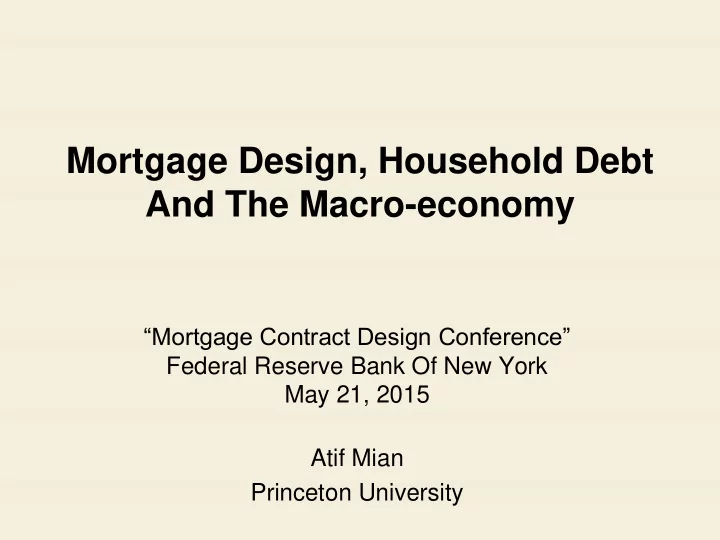

Mortgage Design, Household Debt And The Macro-economy “Mortgage Contract Design Conference” Federal Reserve Bank Of New York May 21, 2015 Atif Mian Princeton University
The Great Mortgaging (JST)
Is growth in household debt a concern? • Standard representative agent models ─ NO ─ Stronger growth in debt forecasts higher income growth
• More recent models that emphasize heterogeneity, financial pecuniary externality, and / or behavioral factors ─ YES ─ Stronger growth in debt forecasts lower income growth (at least beyond a threshold) ─ Private borrowing decisions are suboptimal from a macro perspective as individuals take prices and aggregate leverage as given -> excessive leverage ─ Individuals will not buy optimal insurance even with complete markets
─ Examples: [Bianchi (2011), Caballero and Krishnamurthy (2003), Korinek and Simsek (2014), Farhi and Werning (2014)] ─ Bubbles, asymmetric beliefs, neglected risk all feed into credit growth that increases fragility [Laibson (1997), Barro (1999), Geanakoplos (2009), Shleifer and Vishny (2012)] ─ Focus has shifted from investment / supply-side channel of Bernanke-Gertler to consumption / demand-side channel
How should one deal with problems of excessive debt? • Ex-ante regulation of leverage and capital versus • Ex-ante design of financial contracts that provide automatic state-contingent stabilizer
U.S. Credit Boom Facts (Mian and Sufi 2015b) • Random sample of about 300,000 same individuals followed from 2000-10 • Growth in debt, and subsequent defaults concentrated in low credit score individuals (also see Mian and Sufi (2009)) • Same individuals a lot more sensitive to house price growth (also see Mian and Sufi (2011)) • Income overstatement and fraudulent reporting also extensive in same areas (Mian and Sufi 2015a)
Macro Consequences of Credit Boom • Heterogeneity in MPC creates aggregate demand effects • Fire sale externalities • Employment dislocation and the trade channel • International Evidence (Mian, Sufi and Verner (2015))
Creditor vs Debtor Balance Sheet Leverage Ratio for Homeowners, 2007 By Net Worth Quntile 1 .8 .6 .4 .2 0 Poorest 20% 2 3 4 Richest 20% Debt Home equity Financial wealth
The Distribution of Losses Matters! Poorest 20% Richest 20% 3500 30 3000 20 $ thousands 2500 10 2000 0 1500 1992 1995 1998 2001 2004 2007 2010 1992 1995 1998 2001 2004 2007 2010
The Aggregate Demand Channel .4 .2 0 -.2 -.4 -.3 -.25 -.2 -.15 -.1 -.05 0 .05 Change in housing net worth, 2006-2009
Employment Consequences .1 0 -.1 -.2 -.3 -.25 -.2 -.15 -.1 -.05 0 .05 Change in housing net worth, 2006-2009
The European Example .05 SWE NOR AUS MAL GER FIN BEL SLO SLV LUX FRA CZE 0 ITA DEN NET POR SPA CYP BUL POL CRO UK IRE -.05 EST GRE LIT LAT HUN ROM ICE -.1 -.2 -.15 -.1 -.05 0 .05 .1 .15 .2 Avg. annual current account deficit/surplus as share of GDP (2002-08) houseofdebt.org, @profsufi & @AtifRMian, Data: Eurostat
“the oddest proposal”
Ancient Wisdom • “If any one owe a debt for a loan, and a storm prostrates the grain, or the harvest fail, or the grain does not growth for lack of water, in that year he need not give his creditor any grain, he washes his debt-tablet in water and pays no rent for this year.”
Why are we not there yet?
Thank you!
Recommend
More recommend